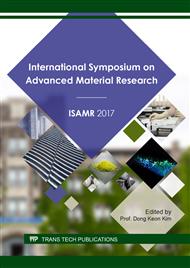[1]
J. C. McDonald, G. M. Whitesides, Poly (dimethylsiloxane) as a material for fabricating microfluidic devices, Acc. Chem. Res. 35(7) (2002) 491-499.
DOI: 10.1021/ar010110q
Google Scholar
[2]
C. Liu, Recent developments in polymer MEMS, Adv. Mater. 19(22) (2007) 3783-3790.
DOI: 10.1002/adma.200701709
Google Scholar
[3]
X. Riedl, et al., A novel PDMS based capacitive pressure sensor, in IEEE Sensors, Hawaii, 2010, pp.2255-2258.
Google Scholar
[4]
C. K. Baby, N. Schwesinger, An Improved Capacitance-Based Intentionally Imperfect Sensor for Measuring Mechanical Parameters, in 8th International Conference on Sensign and Technology (ICST), Liverpool, 2014, pp.230-235.
Google Scholar
[5]
W. Hu, et al., Highly Sensitive and Transparent Strain Sensor Based on Thin Elastomer Film, IEEE Electron Dev. Lett. 37(5) (2015) 667-670.
DOI: 10.1109/led.2016.2544059
Google Scholar
[6]
X. Gong, W. Wen, Polydimethylsiloxane-based conducting composites and their applications in microfluidic chip fabrication, Biomicrofluid. 3(1) (2009) 012007: 1-14.
DOI: 10.1063/1.3098963
Google Scholar
[7]
T. Mirfakhrai, et al. Polymer artificial muscles, Mater. today, 10(4) (2007) 30-38.
Google Scholar
[8]
D. J. Lipomi, et al., Skin-like pressure and strain sensors based on transparent elastic films of carbon nanotubes, Nature nanotech. 6(12) (2011) 788-792.
DOI: 10.1038/nnano.2011.184
Google Scholar
[9]
A. Khosla, "Nanoparticle-doped electrically-conducting polymers for flexible nano-micro Systems}, Electrochem. Soc. Interf. 21(3) (2012) 67-70.
DOI: 10.1149/2.f04123-4if
Google Scholar
[10]
J. Ruhhammer, et al., Highly elastic conductive polymeric MEMS, Sci. Technol. Adv. Mater. 16(1) (2015) 1-10.
Google Scholar
[11]
A. Larmagnac, et al., Stretchable electronics based on Ag-PDMS composites, Scient. Rep. 4(1) (2014) 1-7.
Google Scholar
[12]
C. X. Liu, J. W. Choi, Patterning conductive PDMS nanocomposite in an elastomer using microcontact printing, J. Micromech. Microeng. 19(8) (2009) 1-7.
DOI: 10.1088/0960-1317/19/8/085019
Google Scholar
[13]
X. Niu, et al., Characterizing and patterning of PDMS-based conducting composites, Adv. Mater. 19 (18) (2007) 2682-2686.
DOI: 10.1002/adma.200602515
Google Scholar
[14]
N. Lu, C. et al., Highly Sensitive Skin-Mountable Strain Gauges Based Entirely on Elastomers, Adv. Function. Mater. 22(19) (2012) 4044-4050.
DOI: 10.1002/adfm.201200498
Google Scholar
[15]
V. Tsouti, et al., Modeling and Development of a Flexible Carbon Black-Based Capacitive Strain Senso, IEEE Sensors J. 169(9) (2016) 3059-3067.
DOI: 10.1109/jsen.2016.2524508
Google Scholar
[16]
A. L. Deman, et al., Characterization of C-PDMS electrodes for electrokinetic applications in microfluidic systems, J. Micromech. Microeng. 21(9) (2011) 1-8.
Google Scholar
[17]
N. Lu, et al., Highly Sensitive Skin-Mountable Strain Gauges Based Entirely on Elastomers, Adv. Function. Mater. 22(19) (2012) 4044-4050.
DOI: 10.1002/adfm.201200498
Google Scholar
[18]
J. Dusek, M. Triantafyllou, M. E. Woo, J. Lang, Carbon black-PDMS composite conformal pressure sensor arrays for near-body flow detection, in OCEANS, Taipei, (2014).
DOI: 10.1109/oceans-taipei.2014.6964479
Google Scholar
[19]
K. Chu, S. H. Park, Fabrication of a hybrid carbon-based composite for flexible heating element with a zero temperature coefficient of resistance, IEEE Electron Device Lett. 36(1) (2015) 50-52.
DOI: 10.1109/led.2014.2374698
Google Scholar
[20]
B. A. Reyes, et al., Novel electrodes for underwater ECG monitoring, IEEE Trans. Biomed. Eng. 61(6) (2014) 1863-1876.
Google Scholar
[21]
K. C. Baby, N. Schwesinger, Design and fabrication of individualized capacitive microsensor for tilt measurement, in IEEE Sensors, Busan, (2015).
DOI: 10.1109/icsens.2015.7370610
Google Scholar
[22]
M. Liu, et al., Thickness-dependent mechanical properties of polydimethylsiloxane membranes, J. Micromech. Microeng. 19(3) (2009) 1-4.
Google Scholar
[23]
K. C. Baby, U. Fikri, N. Schwesinger, Resistive Characterization of Soft Conductive PDMS Membranes for Sensor Applications, in IEEE Sensors Applications Symposium (SAS), Catania, (2016).
DOI: 10.1109/sas.2016.7479870
Google Scholar
[24]
D. Stauffer, A. Aharony, Introduction to percolation theory, Florida: CRC Press, (1994).
Google Scholar
[25]
S. Stankovich, et al., Graphene-based composite materials, Nature, 442(7100) (2006) 282-286.
Google Scholar
[26]
D. Prat, et al., CHEM21 selection guide of classical-and less classical-solvents, Green Chem. 18(1) (2016) 288-296.
DOI: 10.1039/c5gc01008j
Google Scholar
[27]
S. Krishnan, On the manufacture of very thin elastomeric films by spin-coating, Massachusetts Institute of Technology, Cambridge, (2007).
Google Scholar
[28]
W. A. Maryniak, et al., Surface resistivity and surface resistance measurements using a concentric ring probe technique, Trek Application Note, 1005 (2003) 1-4.
Google Scholar
[29]
W. Luheng, et al., Influence of carbon black concentration on piezoresistivity for carbon-black-filled silicone rubber composite, Carbon, 47(14) (2009) 3151-3157.
DOI: 10.1016/j.carbon.2009.06.050
Google Scholar
[30]
J. R. Davis, Tensile testing, Ohio: ASM International, (2004).
Google Scholar


